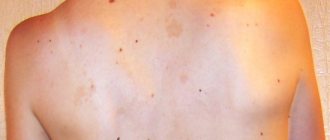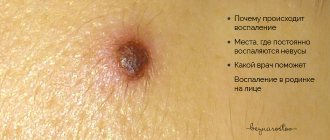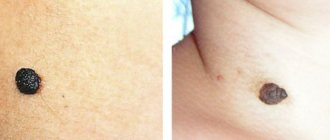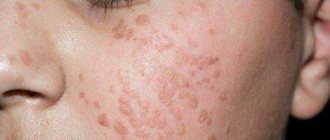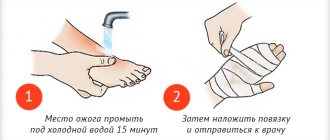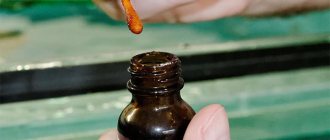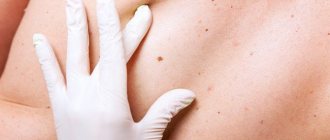A mole is a benign formation that can be found throughout the body. By nature they can be acquired or
congenital. In general, moles do not pose a health risk, except for red ones. A red mole indicates a disease of the gastrointestinal tract, or a hormonal imbalance in the body.
Is mole injury really dangerous?
In RuNet, the danger of traumatizing moles is given excessive, in my opinion, importance. Is there any justification for this point of view? Absolutely, but I think it's quite shaky.
Indeed, there are several studies on this issue, mostly conducted in the 60s–80s of the last century. They show that 30–50% of patients in whom melanoma developed against the background of a nevus noted single or repeated trauma to the mole.
There are several arguments against these studies:
- Just because melanoma develops after trauma to a nevus does not necessarily mean that the two are related. Melanoma could develop both before trauma and much later for other reasons .
- A 2010 meta-analysis (summarizing data from 9 studies) showed that performing an incisional biopsy does not affect the prognosis of melanoma. In other words, if a piece is cut off from melanoma (for diagnostic purposes), this will not negatively affect the patient’s chances of living 5 years or more.
- The conclusions of the authors of several studies (55, 115, 147 and 498 patients) agree on one thing - incomplete removal of nevi, except for dysplastic ones with severe dysplasia, does not lead to the development of melanoma.
Here the corrosive reader will say: “Aha! Still, incomplete removal (you can read “trauma”) causes the development of melanoma!” No. A dysplastic nevus with severe dysplasia itself has a high chance of becoming melanoma in the future. The connection between incomplete removal and the development of melanoma from such nevi has not been proven .
- My experience. Almost every day people write to me who have injured a mole and are now preparing to “die” because they have read too much on the Internet. Almost any person who has a mole protruding above the skin has injured it in one way or another at least once in their life. If trauma to a mole were really a risk factor, in our country with a population of 146,000,000, the diagnosis of melanoma would be made much more often than 8,000 times a year.
Why can't you remove moles?
There are factors that influence the degeneration of a nevus into a malignant tumor - melanoma.
- Excessive sun exposure. Especially during hours of increased ultraviolet activity - from 10.00 to 16.00.
- Genetic predisposition to cancer.
- Repeated mechanical impact on the mole: contact with tight clothing, accidental tearing off. Damage also occurs if it is torn off, scratched, picked out, torn, or touched when shaving. This happens when it is located in an inconvenient place.
As a result of damage to the mole, an infection may enter the affected area and cause an inflammatory process. In this case, the risk of the formation degenerating into a cancerous tumor is high. If the damaged area is treated correctly, the risk of deformation of benign cells is minimal.
What to do if you damage a mole to the point of bleeding?
Mechanical trauma in the form of a scratched, torn, torn off mole is a common phenomenon. A typical situation is that a nevus was picked off and bleeding began to appear. If a mole is on the face, a man may accidentally shave it off. When there is a growth on the back, there is a high probability of catching it inadvertently or picking it apart.
The main thing is not to panic if a mole is ripped off. Blood is just the body's reaction to a wound. We must take measures to stop it.
What will happen to the mole next?
After trauma, as in any other place, the mole will hurt a little and turn slightly red - this is normal. Gradually, after 2-3 weeks, these phenomena should go away on their own. The only situation in which medical intervention may be required is the suppuration of a mole after a severe injury. This means that if after a few days a viscous white (not yellow) liquid begins to come out from the site of injury, you need to be examined by a surgeon. After 1-2 days, a crust will appear at the site of the injury, which will fall off on its own after 1-2 weeks.
Signs of a mole developing into cancer
A mole (birthmark, nevus - dark mole) can degenerate, even if you did not have to pick it out. If you managed to tear or comb a birthmark without knowing it (areas on the back, neck or head that are invisible without a mirror), then the risk of a neoplasm doubles. Signs of cancer development are determined using the ABCDE method, where each letter describes the category and condition of the nevus:
- Asymmetry. A healthy neoplasm is often symmetrical. Conventional division of the nevus in half shows that both parts are identical in shape and size.
- Border irregularity. Cancerous melanoma always has ragged, uneven edges that do not appear clearly.
- Color. A normal mole is a uniform color without inclusions, shades of black, red or gray.
- Diameter. If the diameter of the formation is more than 6 mm, then it is worth showing it to the doctor.
- Tissue variability (evolving). Color, shape, diameter, shade, convexity, size - any unstable characteristic can portend cancer (usually they do not change throughout life).
In a child, a pigmented formation on the skin may increase slightly with age. This is due to the growth of the body and stretching of the skin.
Traumatized, suspicious moles are monitored to see how she looks. Regularly inspect, feel, measure dimensions, take photographs so that it is easy to compare changes over a specific period of time in numbers.
Examine the damaged mole periodically
Inflammation, blood, cracks, itching and tingling, the appearance of papillomas around the mole, areas of tissue death, pus - signs of immediate hospitalization and examination.
How to properly monitor a mole after an injury?
To objectively track changes in a mole, after the inflammation has subsided, you can take a photograph of it against the background of a ruler and compare the original image with subsequent ones. In order for the photo to be of high quality and comparison possible, the following rules must be observed:
- The photo must be taken with a camera, not a phone.
- The photo should not be a “selfie”. In such photographs, the mole is usually out of focus.
- A light source or camera flash should be directed at the mole.
Actions in case of injury
Sometimes damage to a mole can result in it breaking off. In this case, the actions should be as follows:
- The torn piece of skin should not be thrown away. It needs to be placed in mineral water or saline and shown to a doctor.
- After examining the mole and the injured area, the doctor may send the skin fragment for histological examination to the laboratory to rule out malignancy.
- After all the procedures, the doctor will prescribe treatment. At the same time, there is no need to be scared in advance and prepare for a bad result. These procedures are necessary. They will not take much time, but will allow you to receive qualified medical care and avoid unpleasant consequences in time.
Briefly about the main thing:
In my opinion, there is currently no convincing evidence that trauma to a mole can lead to the development of melanoma. Besides me, oncology associations such as NCCN and ESMO also think the same. However, I don’t know if everything was fine with your mole BEFORE the injury. That is why, after the inflammation has subsided, I recommend contacting an oncologist, especially if this specialist has not looked at all of your moles before. If pain, redness, and swelling do not go away within a month, you need to see an oncologist as quickly as possible.
If you still have questions, the following will help you:
- In-person appointment with an oncologist
(St. Petersburg) - Mole removal
with histology (St. Petersburg) - My Online consultation (from anywhere in the world)
Other articles:
- Are moles with jagged edges dangerous?
- Breaking the pattern: 5 myths about mole removal!
- Vital histology
- How to safely remove a mole?
Useful article? Repost on your social network!
How to treat a skinned mole?
To prevent the inflammatory process, the affected area is treated with an antiseptic.
Hydrogen peroxide, chlorhexidine, manganese solution, and alcohol are suitable. When using iodine and brilliant green, you should avoid getting them into the wound itself and apply it along the edges. If pharmaceuticals are not at hand, for example, in the forest, you can use natural antiseptics. These include salt, soda, lemon, onion, garlic. Plants include plantain, chamomile, and pine resin. First aid:
- Stop the bleeding. To do this, wet a cotton swab with hydrogen peroxide and apply it to the affected area for 15-20 minutes. If there is heavy bleeding, change the tampon periodically. If the bleeding does not stop, call an ambulance.
- When the blood stops coming out, cover the wound with a bactericidal bandage. If you only have a regular plaster at home, then first apply cotton wool soaked in an antiseptic.
- The torn area or the entire mole must be preserved in saline solution. Regular saline solution will also work. This material will be needed to examine the mole for the presence of cancer cells.
- After treating the affected area, see a doctor. If necessary, a specialist will prescribe treatment. In some cases, the remaining portion of the growth is removed.
If a child accidentally picks off a mole , first aid is provided in the same way. It is better to wrap the patch with a bandage so that the child cannot peel it off. An important step is to explain to children that picking and scratching moles is dangerous and that care should be taken with these areas of skin.
Even at an early age, melanoma can develop, so a visit to a specialist should not be delayed.
Which doctor should I contact if I tore a mole?
Diagnosis of a damaged mole is carried out by specialists:
- Dermatologist;
- Surgeon;
- Oncologist.
After examination and histological analysis, the doctor recommends special treatment or removal of the mole.
First they visit the surgeon . If necessary, he will refer you to other doctors.
Prevention and safety
If after the first damage to the mole everything went well, then next time the consequences could be much more dire. Therefore, it is better to prevent injury to the nevus. To begin with, you should give up tight and too tight clothes, as well as uncomfortable shoes. But these are not all the rules. So, let's list the main ones:
- You should avoid long manicures if there is a risk of damaging the mole.
- Avoid wearing tight and tight clothing.
- It is necessary to give up uncomfortable shoes. After all, moles can appear even on the feet.
If you don’t want to get rid of long nails, as well as your favorite wardrobe items, then you should take care of your health in advance and remove nevi that may interfere. After all the examinations, the doctor will prescribe surgery.
Other mole removal methods
Recently, people have begun to trust doctors less because of the danger of meeting an unprofessional in a public clinic. Because of this, patients try to get rid of the mole on their own using a thread or other folk methods. There are also enough “healers” who promise to quickly and inexpensively remove an irritating nevus.
Any of the above unconventional methods can lead to blood poisoning, and therefore other negative consequences. Remember that if you pick a mole, you can get blood poisoning. Therefore, if this does happen, you should not sit for a long time and think about what to do in this situation. Get started right away. Remember, prompt medical care is the key to a speedy recovery and the absence of complications.
Which doctor should I contact?
A dermatologist deals with skin problems. He will perform an initial examination, do tests and draw a conclusion about the danger of a mole on the body. If necessary, he will advise and refer you to another specialist.
For patients with dangerous formations, the path lies with a surgeon, oncodermatologist, or dermatologist-cosmetologist.
If a mole is damaged, consult a dermatologist
Signs of pathology
Now you know that you should not pick off black, brown and red moles. It is not difficult to guess what skin cancer is. But how can you determine that a nevus has degenerated? There are several main signs:
- Color change.
- Growth of neoplasm.
- Peeling and severe itching.
If at least one of the listed symptoms occurs, you should immediately seek advice from specialists. In such a situation, it is worth visiting a surgeon or oncologist. If you damage a mole, you should consult a doctor in advance. But, as you know, any disease is easier to prevent than to treat.
First aid
What to do if a mole is cut while shaving?
The best option is to visit a dermatologist as soon as possible. The specialist will examine the wound and tell you what actions to take next, and whether there is cause for concern. If the damage is accompanied by questionable symptoms, the patient may be sent for consultation to an oncologist. But in addition to this, it is necessary to carry out initial treatment of the wound, which will help prevent infection and the development of the inflammatory process.
If a woman cuts off a mole with a razor during depilation of her legs or intimate area, what should she do in such a situation and how to stop the bleeding from the mole after shaving?
- The injured area must be treated with hydrogen peroxide. This substance will help stop bleeding as soon as possible.
- If the wound continues to bleed, apply a gauze bandage. If a mole located in the intimate area is injured, you simply need to apply a piece of bandage soaked in peroxide to it and leave it for 15 minutes.
- Then it is recommended to wash the wound with an antiseptic. It is best to use Miramistin or Chlorhexidine.
- Finally, the affected area must be covered with a plaster.
It is recommended to visit a doctor in any case , even if the damage has begun to heal and does not bother the person. If a piece of the cut nevus remains, it is recommended to wrap it in gauze soaked in saline solution and take it for histological examination.
Read how to get rid of red spots on your legs after depilation.
And here’s what to do if pustules appear in the bikini area after sugaring.
Useful article “How to remove irritation after hair removal in the bikini area.”
How to properly disinfect a wound
It is impossible to say what will happen if you cut off a mole with a razor in the intimate area. The body’s further reaction largely depends on individual characteristics and genetic predisposition. Disinfection plays the most important role in such a situation.
Treatment with antiseptic agents will help prevent infection and the development of the inflammatory process.
It is necessary to understand that the skin in the bikini area and the nevus itself are extremely sensitive. Not every antiseptic drug is suitable for their treatment. Dermatologists recommend using the following products:
- Miramistin. Despite the fact that this antiseptic is one of the most powerful and effective, it has a very delicate effect on tissue and is even suitable for treating mucous membranes. The solution has no contraindications and does not cause side effects;
- Chlorhexidine. Available in alcohol and water based. The second release form is more suitable for treating the intimate area.
As for hydrogen peroxide, this substance is a very weak antiseptic and is more suitable for stopping blood, but not as a disinfectant.
Possible complications
Most often, if hygiene measures are observed, a damaged mole will heal on its own, and this process does not require medical intervention. In what cases should you be wary and urgently go to the doctor?
A visit to a dermatologist is necessary in the following situations:
- the mole does not heal well, bleeds or festers from time to time;
- signs of inflammation appeared near the damaged area - redness, swelling;
- the remaining part of the mole began to grow;
- Itching and burning often occur at the site of injury;
- the boundaries of the formation or its color change;
- a crust has formed on the injured surface, along the edges of which there is peeling.
From time to time it is necessary to inspect intact formations; any change in their appearance should alert you.
If a familiar mole has become loose, different in color, size or shape, or has begun to grow rapidly, you need to visit a medical facility as soon as possible. It is impossible to die from a benign mole, but melanoma that is not diagnosed in a timely manner can quickly lead to death.
How to save material and where to carry it
If you have torn off an entire mole, it is especially important to preserve it for histological examination. To do this, the nevus is placed in a container with a 0.9% sodium chloride solution - saline. If you couldn’t get it, you can prepare the necessary saline solution yourself. To do this, dissolve 1 tsp in 1 liter of boiled water. table salt. Alkaline mineral water is also suitable for the same purpose.
In any case, try to bring the mole to a medical facility as quickly as possible and submit it for analysis.
When an urgent visit to the doctor is necessary
In the normal course of events, the wound left from a torn mole soon heals and heals within 5-7 days. But there are signs that clearly signal: you need to visit a doctor as soon as possible. These include:
- The wound does not heal for a long time and periodically begins to bleed;
- Unpleasant sensations appear in the area of the mole - pain, tingling, burning;
- The injured area turns red and swells;
- The remaining part of the nevus changes color, shape, and texture.
If you notice at least one of the listed symptoms, you need to go to the hospital. First, you should visit a surgeon; if necessary, he will refer you for a consultation with an oncologist. Doctors will prescribe examinations and give advice on further treatment.
Note!
If you need to remove a remaining mole, doctors will help you choose the appropriate method: surgical, laser removal, cryodestruction or electrocoagulation.
Symptoms of a mole developing into cancer
Large, convex nevi need to be closely monitored even if they have never been damaged. The first signs of malignancy may be:
- Change in the shade of the birthmark, both darkening and discoloration, redness of the surrounding tissues;
- Asymmetry – change in the shape of round moles;
- An increase in diameter, the growth of a spot of more than 0.6 cm should be especially alarming;
- Unevenness, blurring of the edges of the nevus;
- The appearance of bleeding cracks in the area of the birthmark without previous trauma;
- Changes in the texture of the mole tissue - the appearance of compactions or areas of softening;
- Hair loss from the nevus;
- The appearance of discomfort in the pigmentation area - burning, itching, pain.
In such cases, you need to get an appointment with an oncologist as soon as possible.
Where do moles come from?
A mole (nevus) is an area of high concentration of pigment cells, melanocytes, in the skin. Depending on the amount of pigment accumulated in the cells, birthmarks come in different colors - from pale brown to purple.
As a rule, nevi are formed due to:
- Hereditary predisposition;
- Excessive exposure to ultraviolet radiation on the skin, prolonged exposure to the sun;
- Hormonal imbalances;
- Viral skin lesions.
Moles appear from infancy, but most of them appear during puberty in adolescents against the background of hormonal changes.
Peculiarities!
According to statistics, birthmarks are more often located on the face than on the body, since the face is usually not covered by clothing from the sun's rays. Sometimes moles form on mucous membranes.
